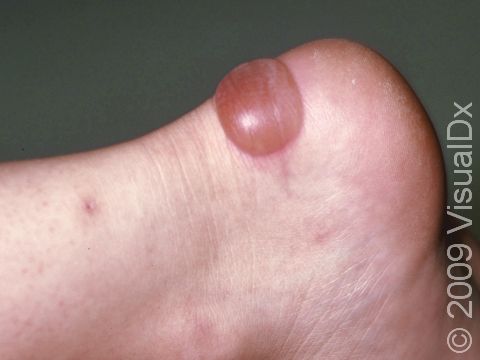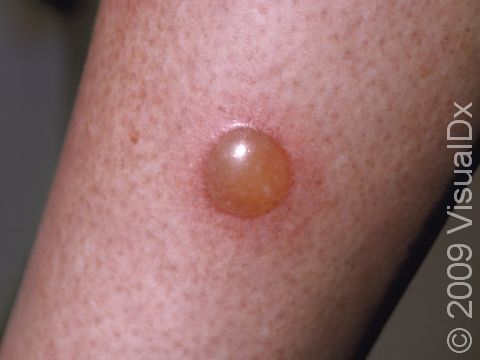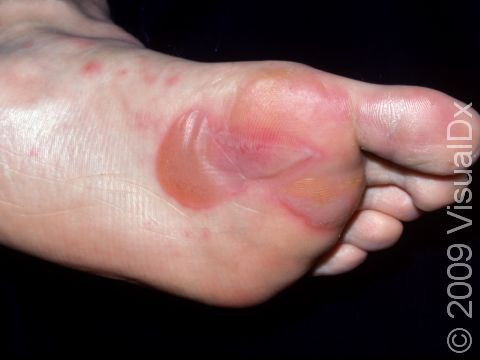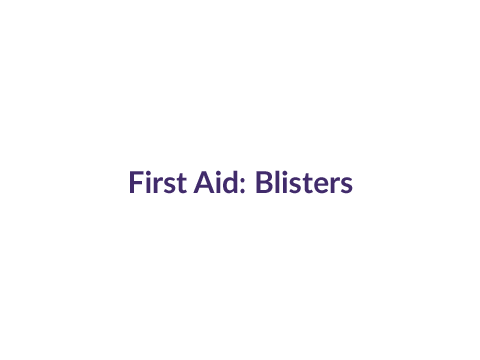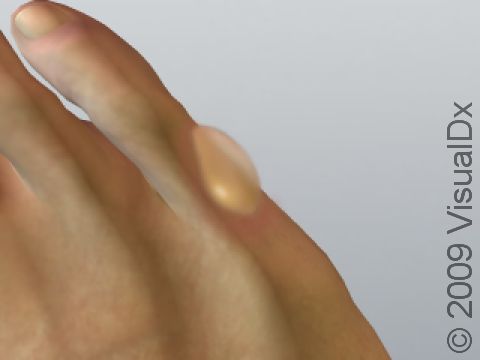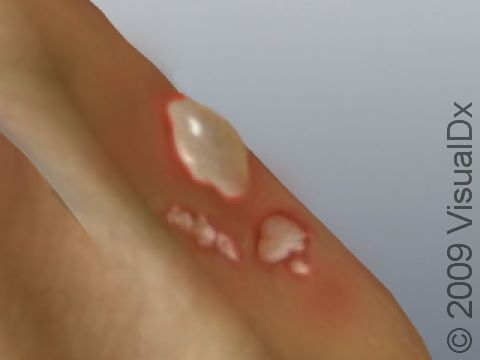Blisters, First Aid
A blister (bulla) is caused when the outer layer of the skin separates from a layer of skin below, creating a collection of fluid between the layers. Blisters can be caused by chemical means, such as an allergic reaction; physical injury, such as from heat, frostbite, or friction; or from a disease.
If the blister has been caused by a burn, see the Burns, First Aid write-up via the Disease List. If the blister has been caused by frostbite, see the Frostbite, First Aid write-up, which can also be found via the Disease List.
First Aid Guide
Blisters often go away on their own without needing any care, and the skin over the blister is its best defense against infection. If the blister is large or painful, however, you can drain the blister in such a way as to relieve the discomfort and hopefully avoid infection. Note: Blisters that look like they will pop on their own should be drained, unless the blister looks infected or you have a fever; multiple, grouped blisters; diabetes; or poor circulation.
- Clean your hands and the affected area with soap and warm water.
- Apply rubbing alcohol to the affected area.
- Wipe a needle with rubbing alcohol to sterilize it.
- Puncture the blister with the sterilized needle at its edge, making the hole big enough to drain fluid.
- Let the fluid drain, making sure to leave the overlying skin in place. Note: This skin will help prevent infection.
- Apply an antibiotic ointment (eg, bacitracin) to the blister, and bandage the affected area.
- Once the overlying skin has dried, allow it to fall off naturally or use sterilized scissors to cut the dead skin off. Apply antibiotic ointment and a bandage, if necessary.
Prevention of blisters is key. The following measures will help prevent blisters from occurring:
- Wear acrylic socks, particularly ones that fit you well. While cotton socks were once the recommendation to avoid blisters, they tend to become misshapen when wet and are never as form-fitting as acrylic socks.
- When picking out shoes, be sure to go shopping during the middle of the day, when your feet are slightly swollen. (Feet normally swell as the day goes on.) Make sure you can wiggle your toes, and be sure that both the left and right shoes fit properly. (Many people have two different size feet.)
- Apply powder to your feet before activity that may cause friction.
- Wear work gloves when using tools that cause friction on hands.
Who's At Risk?
Athletes are at high risk of acquiring blisters due to repetitive friction between skin and shoes, socks, and sports equipment. Additionally, those who wear ill-fitting, uncomfortable shoes or who handle tools that cause friction are at risk for getting blisters.
Signs & Symptoms
Blisters typically develop on the soles of feet and the palms of hands when there is friction and irritation on the surface layer of the skin.
Depending on the severity as well as the stage of the blister, the appearance may vary.
- Early stage blisters – redness of the skin on the affected area, such as on the heel, the instep, toes, or palms.
- Mild, middle stage blisters – the affected area forms into a bubble-like swelling under the skin. The fluid is clear.
- Moderate or severe, middle stage blisters – the affected area forms into a bubble-like swelling under the skin and may be quite large. Infected blisters look red around the edge, and the fluid is often pus-like or red. Additionally, infected blisters are painful and warm to the touch.
- Late stage blisters – as the blister heals, the skin on the blister dries and typically sloughs off naturally, leaving healthy skin underneath.
Self-Care Guidelines
Treatments
If the blister becomes infected, your doctor may want to prescribe antibiotics. Depending on the cause of the blister, your doctor may treat the blister ranging from conservative measures, such as watchful waiting, to treating the source of the blister(s) if caused by a disease.
Visit Urgency
See your doctor if you think your blister may be infected (ie, the blister is very red or warm to the touch, painful, oozing pus, or blood-filled); there are multiple, grouped lesions; you have a fever, poor circulation, diabetes, or an autoimmune disease; or if you are not feeling well.
Trusted Links
Last modified on October 6th, 2022 at 2:46 pm

Not sure what to look for?
Try our new Rash and Skin Condition Finder
